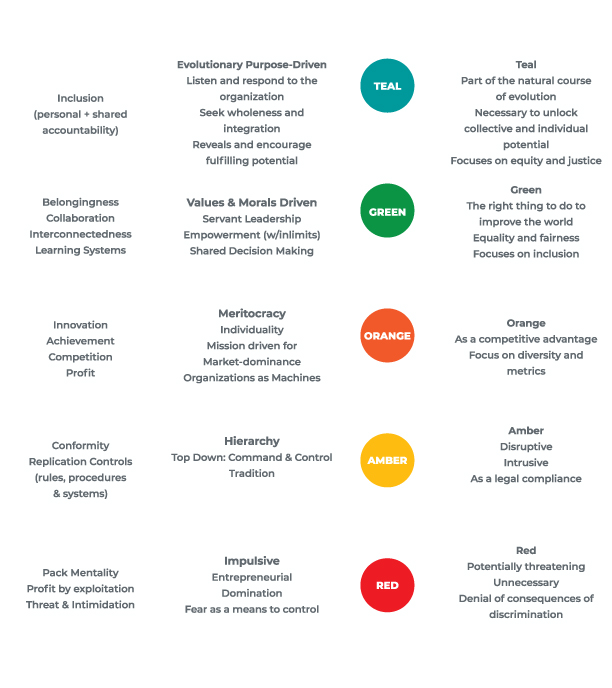Are Your Values Aligned With The Inclusive Leader You Want To Be?
In organizations operating at the green level decisional dynamics are intentionally less “top down” and are more “bottom up” with an emphasis on distributing power to avoid traditional hierarchies.
Share This Post
The Green Level Mindset
The optimal Teal (Evolutionary Purpose-Driven) level of the Evolutionary Guide to DEI only becomes possible when a sense of personal and shared accountability within an organization makes inclusion a real, dynamic aspect of the workplace culture. In order to achieve the optimal Teal level and realize all the benefits that inclusion brings as a leader, you’ll need to take proper stock of your current mindset and make an honest assessment of how your organizational culture is playing out now. As part of our series exploring the Evolutionary Guide to DEI by highlighting the four leadership lenses preceding Teal, this article looks at the Green (Values Morals Driven) mindset. Like the Red, Amber, and Orange levels we’ve discussed before, the Green leadership style has some seemingly positive qualities. Nevertheless, it still falls short in terms of drawing out everyone’s full potential and helping organizations truly thrive.
Don’t Confuse Collaboration With Inclusion
The Green leadership orientation originated about 150 years ago with appreciation for holistic thinking, diversity, harmony, human development, conservationism, subjectivity (personal feelings and values), peace, collaboration, collectivism, interpersonal connectivity, and equanimity. It views the world as a habitat for humanity shared by and cared for by all.
In Green organizations, there is an emphasis on empowerment (with limitations noted below), shared decision-making, and a notion that leaders are meant to serve the greater good rather than wield power. Decisional dynamics are intentionally less “top down” and are more “bottom up” with an emphasis on distributing power to avoid traditional hierarchies. The Green leadership approach reflects a commendable desire to do the right thing in order to improve the world, making it a more socially-conscious outlook than Red, Orange, and Amber. Even so, Green leaders/organizations face critical limitations with respect to inclusion.
What The Green Lens Can’t See
The insistence on belongingness, collaboration, and interconnection within Green organizations can easily be misinterpreted as fidelity to DEI.
But despite their intentions toward justice and tolerance for human differences, Green-level leaders tend to lack the mindset and skills necessary for inclusion. Here are some common DEI blind spots associated with Green leaders/organizations:
Projection
Leaders at this level tend to project their own cultural lens onto others but generally lack awareness of that habit. These leaders likewise institutionalize their own sensibilities by judging others based on the presumption of shared ideals, such as by selecting people for promotions who fit their profile of what a collaborative leader should be like and ignoring those who don’t. This can unwittingly limit who is at the table and perpetuate professionalized workplace standards that seem to promote quality and empowerment while actually impeding inclusion.
The “We have arrived!” Complex
Green level leaders/organizations often misguidedly believe that they are already inclusive, making it justifiable to overlook DEI initiatives because they seem superfluous, unnecessary, or something that the organization has already moved beyond.
Equality = Equity Blindness
Green organizations commonly suffer from an inability to differentiate between justness and fairness versus equity. In striving to give all employees the same treatment, they fail to recognize and account for the variations in what people need to succeed.They frequently profess colorblindness and assert a belief that all human beings are essentially the same, rendering the concept of equity effectively–and problematically– irrelevant in their worldview.
The Pluralism Conundrum
Though there is a strong interest in collaboration and consensus from the Green point of view, decision-making is often functionally stunted by the notion that truth is relative. An emphasis on objective respect for all subjective views results in impasse and the default preservation of the status quo.
Distorted Egalitarianism
The absence of hierarchical power structures doesn’t actually promote empowerment or fairness within Green organizations because power merely gets shifted into informal dynamics rather than being consciously transformed into initiatives for equity. Coupled with the pluralism conundrum, distorted egalitarianism can mean that influence within a Green organization is based on likeability instead of real shared responsibility and accountability, the opposite of what inclusive organizations are striving for.
Blind Spots Are Surprisingly Revelatory
The Green mindset comes with important departures from other organizational paradigms that are incompatible with inclusion, yet it can only take us so far. Luckily with DEI, blind spots have a way of showing us the path forward. Understanding the motivations, characteristics, and limitations of leadership approaches associated with the Red (Impulsive), Amber (Hierarchy), Orange (Meritocracy), and Green (Values Morals Driven) levels can orient you and become a guide on your inclusive leadership journey. At Beyond Inclusion Group, we’ll assess your center of gravity in the Evolutionary Guide to DEI, help you navigate those prevailing yet avoidable blind spots, and work together to create a clear strategy to evolve into a strong, effective, evolutionary purpose-driven leader.

Read more Posts

5 Signs Your Leadership Isn’t Evolutionary (and Why It Matters)
“Studies reveal that more than 40% of our behaviors are driven by fixed beliefs, habits, biases, and blind spots.”

Leading Through Complexity: How Purpose-Driven Evolutionary Leaders Can Navigate the DEI Backlash
“Evolutionary leaders aim to build trust, encourage collaboration, and guide their teams through change with purpose and empathy.”